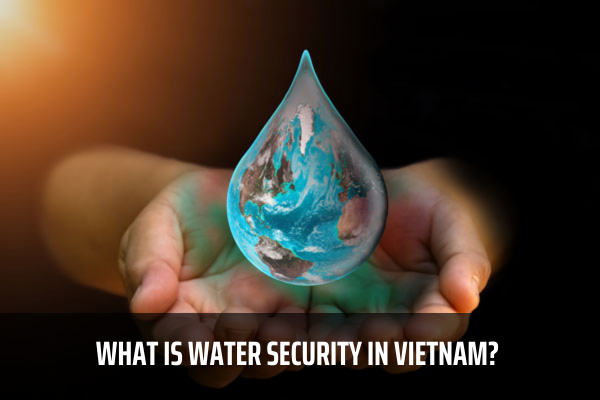What is water security in Vietnam? What are the objectives for ensuring water security and dam safety until 2030, with a vision towards 2045?
What is water security in Vietnam?
Pursuant to the provisions of Clause 23, Article 2 of the Law on Water Resources 2023, the term of "water security" shall be construed as follows:
“Water security” means the assurance about quantity and quality of water to secure livelihoods in all circumstances, meeting the demands for using water for socio-economic development, national defense, security and environmental activities and minimizing water-related risks and damage caused by human beings and nature.

What is water security in Vietnam? (Image from the Internet)
What are the objectives for ensuring water security and dam safety in Vietnam until 2030, with a vision towards 2045?
Pursuant to Conclusion 36-KL/TW of the Politburo in 2022 regarding ensuring water security and dam safety until 2030, with a vision towards 2045, the following objectives are outlined for ensuring water security and dam safety:
General objective:
Ensuring the quantity and quality of water for domestic use in all situations; meeting the water needs for production and business activities of various sectors, particularly important and essential sectors; ensuring equitable and rational access to water for all people and entities. Actively storing and managing water resources, efficient exploitation and use in conjunction with ensuring dam safety; effective response to water-related disasters and climate change; protecting the environment and addressing issues of depletion, degradation, and pollution of water sources.
Specific objectives:
- By 2025: Complete the development of national sectoral planning and technical planning related to water; 95% of urban households and 60% of rural households have access to clean water meeting the standards; address the basic water shortage for domestic use, production, especially in the Mekong Delta, Central Highlands, South Central Coast, and Northern mountainous regions; repair and upgrade damaged and degraded dams and reservoirs to ensure flood control capabilities according to design requirements.
- By 2030: Achieve a balance between water supply for domestic use and socio-economic development; 100% of urban households and 80% of rural households have access to clean water meeting the standards. Address the basic water needs for inhabited islands; complete the integrated system of regulating saltwater and freshwater, water storage on major river basins; complete the repair and upgrade of damaged, degraded, and flood-prone dams and reservoirs; begin to address serious depletion and pollution of water sources in some river basins and large irrigation systems; proactively respond to natural disasters and adapt to climate change; establish and operate a national water security monitoring, evaluation, and supervision system following international water resource management practices.
- By 2045: Proactively ensure water supply for domestic use and socio-economic development; ensure rural households have access to clean water meeting the standards; forecast and provide long-term warnings to address water pollution, depletion, and scarcity, as well as cope with natural disasters and climate change; regulate and address the depletion and pollution of water sources in river basins and irrigation systems; improve comprehensive water policies, inter-sectoral and inter-regional coordination, and ensure water security.
What are 06 State policies on water resources in Vietnam under the Law on Water Resources 2023?
Pursuant to the provisions of Article 4 of the Law on Water Resources 2023, there are 06 new State policies on water resources as follows:
(1) Modernize and professionalize the management of water resources in the direction of managing national water resources on the digital platform through the national water resources information system and database, and system of decision support tools, ensuring the efficient use of resources for water resources management.
(2) Prioritize the investment in the prospecting, exploration and exploitation of water sources, water retention and restoration of deteriorated, depleted or polluted water sources; offer incentives for water exploitation projects aiming to supply domestic and production water to inhabitants in areas facing fresh water scarcity, ethnic minority areas, mountainous areas, border areas, on islands, disadvantaged areas, extremely disadvantaged areas; enable the poor, women, children, persons with disabilities and other vulnerable persons to have access to domestic water.
(3) Prioritize the investment in creation of water resources monitoring and surveillance network, national water resources information system and database, and enhancement of the capacity for forecasting water resources, floods, inundations, droughts, saltwater intrusion, sea level rise and other damage caused by water.
(4) Encourage, incentivize, and assist organizations and individuals to participate in conducting baseline survey of water resources; protect and develop water sources and water generation sources; store water and restore deteriorated, depleted, and polluted water sources; regulate and distribute water resources; prevent, respond to and recover damage caused by water.
(5) Encourage organizations and individuals to develop and apply standards, research, transfer and apply advanced science and technology to manage, protect, restore and develop water resources; exploit and use water in an economical and effective manner, use water in a circular manner, reuse water; convert seawater into fresh water; collect and use rainwater, artificially recharge groundwater; restore deteriorated, depleted and polluted water sources; prevent, respond to and recover damage caused by water.
(6) Expand and strengthen international integration and cooperation in water resources.
LawNet